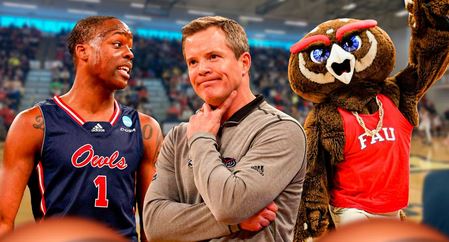Podcast: Play in new window | Download
Subscribe: RSS
How did three of this year’s men’s basketball Final Four participants make it onto the biggest stage for the first time in program history?
One theory is that the NCAA tournament committee simply goofed this year.
I just finished reading a book by ESPN college basketball bracketology guru Joe Lunardi. His book is titled (you guessed it) “Bracketology”.
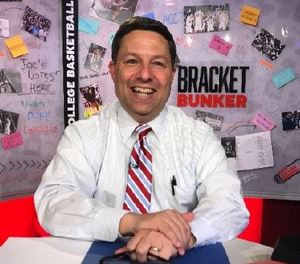
Joe Lunardi was raised in Philadelphia, went to hometown St. Joseph’s University and worked in the communications office at St. Joe’s, too. He became really interested in college basketball as a youth.
Lunardi closely followed the statistics for all of the intra-city college basketball battles between the Philadelphia Big 5 (St. Joes, LaSalle, Penn, Temple, and Villanova). Basketball games between these schools (which are located within 17 miles of each other) have been played at the historic Palestra on the campus of Pennsylvania University since 1927.
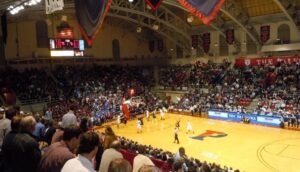
After his professional work career began, Joe Lunardi spent more time on his hobby of trying to guess the NCAA’s men’s basketball March Madness field. He read extensively. He purchased magazines and followed the weekly ratings services during the basketball season. He even talked to former members of the NCAA selection committee to learn more about their criteria for team selection.
Joe Lunardi’s own NCAA men’s basketball predictions about the teams likely to be selected for March Madness became very accurate. So much so that he has parlayed it into a lucrative career on television working exclusively with ESPN. He not only predicts which teams are going to make the field, he assigns the likely tournament seeding for each team.
Historically, Lunardi’s predictions (if not spot-on) usually miss by only one team.
This year, he predicted Rutgers would make the field. Instead, Nevada made it. Though Rutgers would be selected for the NIT Tournament, both Nevada and Rutgers lost in the first round of their post-season tournament games.
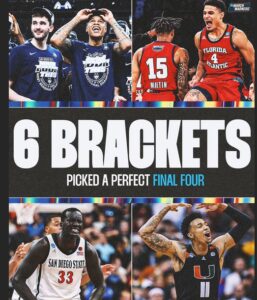
Though Joe Lunardi’s book does not reveal his secrets, he shared a few interesting tidbits relating to how the NCAA Committee determines the teams which make the field.
Statistically speaking, college basketball teams playing in their home gym win an average of 70% of the time.
In November and December, the most popular college basketball schools like Duke, Kentucky, and Kansas rarely travel. Their games are usually played in front of sell-out home crowds.
By playing nearly all of their early season games at home, most big name schools generally run-up a rather impressive won-loss record in the first half of the season, too. In the second half of the year, a tougher conference schedule must be navigated.
For teams in the major conferences such as the ACC, SEC, and Big 12, the goal is to win as many games early season games as possible and then try to post a winning record in conference play.
That formula generally works well as most of those teams will punch a ticket into March Madness.
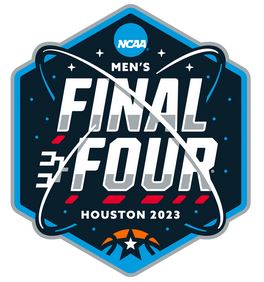
But what about the colleges playing in the smaller conferences?
Much like college football, many of the smaller schools earn more guaranteed money by traveling to play road games against the big-name powers. Statistically speaking, those schools have only a 30% chance of winning a game being played at an opponent’s gymnasium.
If a smaller college wants to gain more attention from the NCAA March Madness selection committee, they need to hit the road a few times early in the year to play (and beat) one or more of the traditional powers in their home gym.
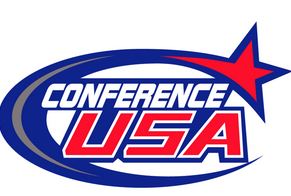
Florida Atlantic University of Conference USA (which sports a glittering 35-3 record entering this weekend’s Final Four) needed to do that this season.
The Owls had two early season road tests at Florida (a win) and Ole Miss (a loss). Playing and winning one or more out-of-conference games in the arena of a power conference (SEC, in this case) helps to elevate the team’s competitive reputation.
This year, the FAU Owls won Conference USA with an impressive 18-2 record.
Surprisingly, did you know that #2 and #3 teams in C-USA (North Texas and UAB) faced each other on Thursday night in the finals of the NIT Tournament? North Texas won 68-61 and finished the season with a stellar 30-7 record.
The Florida Atlantic Owls played in what turned out to be a very tough conference this year. However, the NCAA committee only gave FAU a #9 seed in this year’s March Madness basketball tournament. It left North Texas and UAB completely out of the field.
Conference USA’s top three teams have vastly overachieved this season based on what the so-called “experts” had predicted.
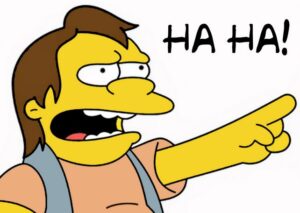
As Joe Lunardi pointed out in his “Bracketology” book, his job is to predict which teams should be selected for the March Madness field. He also assigns the likely seed (1-16) based on each team’s season of work.
In the book, Lunardi stated that two teams playing on a neutral court generally have no statistical advantage over the other. Each team has a 50/50 chance of winning when the game is played at a neutral site location.
Hmm. The NCAA men’s basketball tournament tries to schedule most of its opening round games at neutral sites. It would seem very logical that the 50/50 nature of NCAA March Madness games played at neutral sites in the early rounds insures there will be a lot of (theoretical) “upsets”.
This year proved to be no exception.
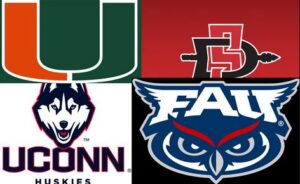
But were these truly upsets? Take a closer look at the Final Four teams.
There are three regular season conference champions. Conference USA champ Florida Atlantic (a #9 seed), ACC regular season winner Miami (a #5 seed), and the Mountain West Conference regular season winner San Diego State (a #5 seed) were not given enough credit for their conference records.
The other team in this year’s Final Four is #4 seed Connecticut.
The Huskies finished in fourth place in the regular season of the Big East Conference. They trailed Marquette, Xavier, and Creighton (which all made the field, too).
Prior to rolling off four straight wins in the NCAA tournament, UConn had won six of its last seven games in the Big East Conference (losing only by two points to Marquette in the league championship game). Winners of 11 of their last 12 games, the Huskies have breezed through the first four games of the March Madness tournament.
Each of the Final Four teams has defeated one or more of the top seeds to advance to Saturday’s semifinal game in Houston. This year’s NCAA seeding was a bust.
The biggest underdog in the field is Florida Atlantic. Their head coach is a lot like his team. Dusty May, a long-time assistant coach at Louisiana Tech and, more recently, at Florida, was overlooked for many years.
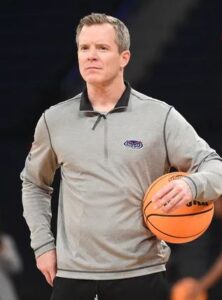
Dusty May played high school basketball in central Indiana. Just like in the movie “Hoosiers”, the high school gymnasium at Eastern Greene becomes the county’s focal point during basketball season.
After he accepted a college basketball scholarship to play for Oakland University in suburban Detroit, Dusty May didn’t like the idea of spending most of his college days sitting on the bench. He told his coach that he wanted to transfer to Indiana University.
No, he didn’t want to play basketball for Coach Bobby Knight. He wanted to become the Hoosiers’ student manager and study under the legendary basketball coach. This guy was destined to become a coach!
Today, there is a new high school gymnasium in Eastern Greene, Indiana which seats 3,000. Dusty May’s current employer at Florida Atlantic University near the Atlantic Ocean in Boca Raton, Florida has a college gym which seats 500 fewer fans than at his high school.
By virtue of the FAU Owls flying into this year’s Final Four in Houston, the team and its impressive 46-year old basketball coach have defied the odds.
The Owls received some good news on Friday as coach Dusty May has agreed to a long-term contract extension to remain with the Boca Raton beachside school.
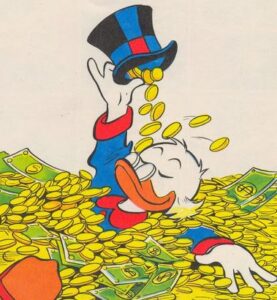
This year’s surprising Final Four field has proven one of Joe Lunardi’s personal beliefs to be true.
To his credit, he believes that the NCAA March Madness field has become bloated with marginal teams from the largest basketball conferences. He suggested that the NCAA field should never include a team which had a losing record in conference play.
Right on, Joe!
By following that common sense idea, three teams would have been left out in favor of more deserving teams such as C-USA’s North Texas Mean Green and the 28-10 UAB Blazers. The Big 12’s West Virginia (7-11 in conference play) and the SEC’s Mississippi State and Arkansas (both with 8-10 records in conference games) should have been playing in the NIT this year.
West Virginia and Mississippi State were both bounced out of the NCAA tournament in Round One. Arkansas won its first two games before being overwhelmed by UConn in the Round of 16.
Despite his year-long obsession with NCAA basketball, Joe Lunardi says that he is horrible at picking his own NCAA bracket winners for the office pool – just like the rest of us.
In a recent year, a family member named Murray even won more games than Lunardi did.

Murray is the family dog. He selected Murray State (of course) to win it all. In other games, he selected teams with dog nicknames. In all other matchups, he selected (get ready) the underdogs in each game.
Over the weekend, ninth-seeded Florida Atlantic University has a chance to become the highest seed to ever win the NCAA men’s basketball tournament. In 1985, Coach Rollie Massimino’s eighth seeded Villanova Wildcats rolled-off six straight wins to grab the title.
The Florida Atlantic Owls have flown into Houston with a chance to make March Madness history. With all due respect to Joe “Mr. Bracketology” Lunardi, FAU can become the biggest bracket buster of all-time if they should win their next two games.

And WHO would have believed that just three weeks ago?

